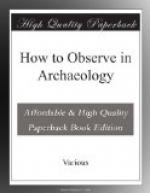PART II
INTRODUCTORY NOTE
The aim of the special sections contained in Chapters III-VIII is to describe, not the objects usually to be seen in Museums, but only such things as will be found lying out on mounds and sites, and as are more or less distinctive of a period. Thus certain comparatively trivial objects are named, because they are peculiar to a period, and likely to be found in a casual passage over a site, whereas other objects, common to several periods, are ignored. Only the distinctive, key objects are mentioned. The great features of Greek Art, for instance, are not dealt with in Chapter ii; nor are coins, the probabilities of finding them being too slender, and the possibilities too wide. Nevertheless, coins when found should be carefully quoted. Pottery naturally takes the largest place, as it was abundant, and its fragments are a good guide to period, and being practically indestructible and of no intrinsic value are most likely to be met with. The difference between pottery made with the use of the wheel and that made without is important to be noted. The use of the wheel can usually be detected through the slight inequalities of the clay that make a series of parallel lines on the inner surface. The diagrammatic representations of the pot-forms characteristic of various periods or of other objects ranging through a civilization the main features of which can be shown in outline will, it is hoped, be found useful. Simplified tables of alphabets, intended to make it possible roughly to identify the script, if not the date, of an inscription, are also given.
CHAPTER I
FLINT IMPLEMENTS
See Diagrams, [Illustrations ii: Flint Implements]
As the development of Flint Implements follows more or less the same course in all the districts with which this volume deals, a general description is given here, to avoid repetition in the special sections.
The earlier periods of man are so remote that geological changes, wet, and decay, have removed nearly all his works except the flint tools. It is to these chiefly that we must look for our knowledge of his abilities. Flints are nearly all that we have for the early stages, to supply what arts, history, and literature give in later stages. To preserve and educe all we possibly can obtain from their situation, and purpose, is a main duty to history. To destroy or confuse the evidence, by removing specimens without a record, or by shifting them to a different place, is a crime in science. As there is no temptation to ignorant peasants to move flints until they are induced by collectors, so the whole fault of the wreckage that has taken place in many sites lies on the plundering collector. No money or reward should be given for any flints; a few fine specimens may be lost, but vastly more harm would be done by encouraging mere raiding.




